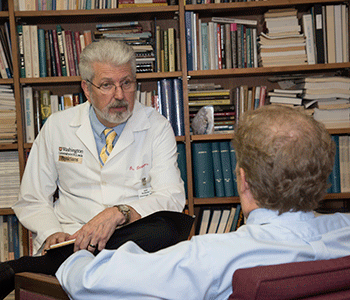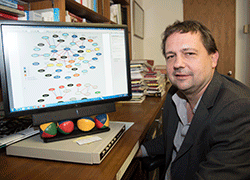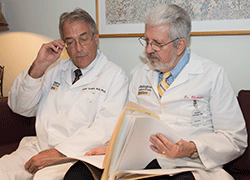
New research shows that schizophrenia isn’t a single disease but a group of eight genetically distinct disorders, each with its own set of symptoms. The finding could be a first step toward improved diagnosis and treatment for the debilitating psychiatric illness.
The research at Washington University School of Medicine in St. Louis is reported online Sept. 15 in The American Journal of Psychiatry.
About 80 percent of the risk for schizophrenia is known to be inherited, but scientists have struggled to identify specific genes for the condition. Now, in a novel approach analyzing genetic influences on more than 4,000 people with schizophrenia, the research team has identified distinct gene clusters that contribute to eight different classes of schizophrenia.
“Genes don’t operate by themselves,” said C. Robert Cloninger, MD, PhD, one of the study’s senior investigators. “They function in concert much like an orchestra, and to understand how they’re working, you have to know not just who the members of the orchestra are but how they interact.”
Cloninger, the Wallace Renard Professor of Psychiatry and Genetics, and his colleagues matched precise DNA variations in people with and without schizophrenia to symptoms in individual patients. In all, the researchers analyzed nearly 700,000 sites within the genome where a single unit of DNA is changed, often referred to as a single nucleotide polymorphism (SNP). They looked at SNPs in 4,200 people with schizophrenia and 3,800 healthy controls, learning how individual genetic variations interacted with each other to produce the illness.

In some patients with hallucinations or delusions, for example, the researchers matched distinct genetic features to patients’ symptoms, demonstrating that specific genetic variations interacted to create a 95 percent certainty of schizophrenia. In another group, they found that disorganized speech and behavior were specifically associated with a set of DNA variations that carried a 100 percent risk of schizophrenia.
“What we’ve done here, after a decade of frustration in the field of psychiatric genetics, is identify the way genes interact with each other, how the ‘orchestra’ is either harmonious and leads to health, or disorganized in ways that lead to distinct classes of schizophrenia,” Cloninger said.
Although individual genes have only weak and inconsistent associations with schizophrenia, groups of interacting gene clusters create an extremely high and consistent risk of illness, on the order of 70 to 100 percent. That makes it almost impossible for people with those genetic variations to avoid the condition. In all, the researchers identified 42 clusters of genetic variations that dramatically increased the risk of schizophrenia.
“In the past, scientists had been looking for associations between individual genes and schizophrenia,” explained Dragan Svrakic, PhD, MD, a co-investigator and a professor of psychiatry at Washington University. “When one study would identify an association, no one else could replicate it. What was missing was the idea that these genes don’t act independently. They work in concert to disrupt the brain’s structure and function, and that results in the illness.”
Svrakic said it was only when the research team was able to organize the genetic variations and the patients’ symptoms into groups that they could see that particular clusters of DNA variations acted together to cause specific types of symptoms.
Then they divided patients according to the type and severity of their symptoms, such as different types of hallucinations or delusions, and other symptoms, such as lack of initiative, problems organizing thoughts or a lack of connection between emotions and thoughts. The results indicated that those symptom profiles describe eight qualitatively distinct disorders based on underlying genetic conditions.

The investigators also replicated their findings in two additional DNA databases of people with schizophrenia, an indicator that identifying the gene variations that are working together is a valid avenue to explore for improving diagnosis and treatment.
By identifying groups of genetic variations and matching them to symptoms in individual patients, it soon may be possible to target treatments to specific pathways that cause problems, according to co-investigator Igor Zwir, PhD, research associate in psychiatry at Washington University and associate professor in the Department of Computer Science and Artificial Intelligence at the University of Granada, Spain.
And Cloninger added it may be possible to use the same approach to better understand how genes work together to cause other common but complex disorders.
“People have been looking at genes to get a better handle on heart disease, hypertension and diabetes, and it’s been a real disappointment,” he said. “Most of the variability in the severity of disease has not been explained, but we were able to find that different sets of genetic variations were leading to distinct clinical syndromes. So I think this really could change the way people approach understanding the causes of complex diseases.”
Comments and respectful dialogue are encouraged, but content will be moderated. Please, no personal attacks, obscenity or profanity, selling of commercial products, or endorsements of political candidates or positions. We reserve the right to remove any inappropriate comments. We also cannot address individual medical concerns or provide medical advice in this forum.